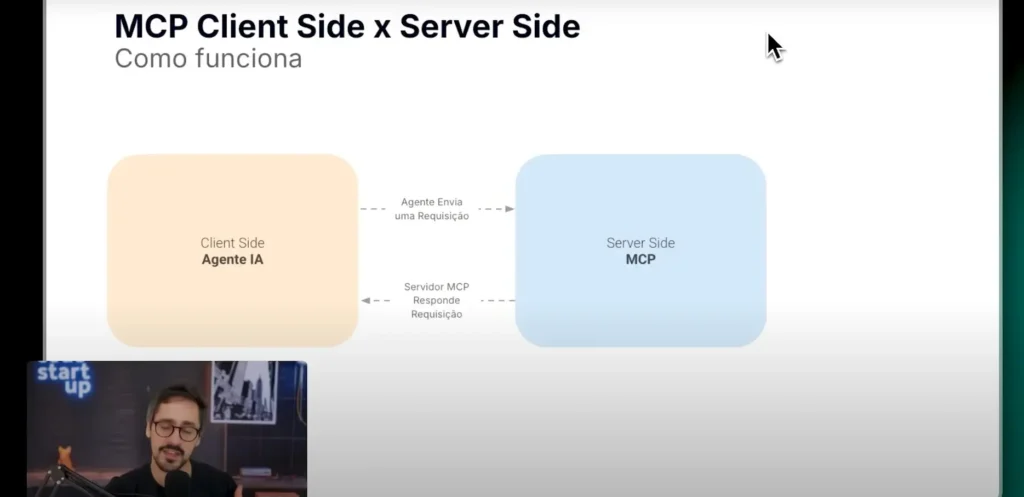Lançado em novembro de 2024 pela Anthropic, o Machine Communication Protocol (MCP) transformou a maneira como AI agents interagem com serviços on‑line.
Em vez de programar cada chamada de API, você descreve funções num manifesto JSON e o agente executa tudo sozinho.
O N8N incorporou suporte nativo ao MCP, permitindo publicar ou consumir servidores sem escrever código.
Neste tutorial, você entenderá por que o MCP é considerado revolucionário, quando vale adotá‑lo e como testá‑lo em um fluxo real.
1. Por que o MCP é revolucionário?
O MCP conecta diretamente agentes de IA a serviços, eliminando etapas de programação manual e tornando as conversas capazes de criar clientes, emitir faturas ou ler planilhas em tempo real.
A adoção por empresas como Stripe indica que esse modelo de comunicação tende a se consolidar como padrão nos próximos anos.
2. As três fases de evolução dos agentes de IA

- Acesso a APIs via código: o desenvolvedor escreve todas as requisições HTTP.
- Ferramentas embutidas: plataformas expõem funções internas prontas para o modelo.
- Protocolos abertos (MCP): qualquer serviço documentado se torna plug‑and‑play, permitindo escalabilidade quase instantânea de capacidades.
3. O que é MCP e como ele funciona
O MCP é, essencialmente, uma especificação que descreve funções, parâmetros necessários e exemplos de uso em um arquivo JSON.
Quando o agente lê esse manifesto, ele sabe exatamente qual chamada fazer e como tratar a resposta, sem instruções adicionais no prompt.
Em outras palavras, o manifesto substitui a necessidade de código customizado: basta atualizar o arquivo e novas funções ficam disponíveis, enquanto a lógica de erro e autenticação permanece centralizada.
4. Diferença entre MCP Client e MCP Server

| Papel | O que faz | Quando usar |
| Client | Consome manifests publicados por terceiros. | Você quer acessar rapidamente recursos de serviços externos (ex.: criar pagamentos no Stripe). |
| Server | Publica seu próprio manifest. | Precisa expor processos internos — do CRM ao ERP — como funções que qualquer agente pode acionar. |

5. Benefícios do uso do MCP em projetos de IA

Adotar MCP reduz manutenção de código, padroniza entradas e saídas, facilita governança (você define apenas as ações permitidas) e acelera prototipagem.
Adicionar ou remover funcionalidades vira uma simples edição no manifesto, sem impactar prompts ou fluxos existentes.
6. Comparação: API tradicional vs. MCP

| Aspecto | API REST convencional | MCP |
| Público‑alvo | Desenvolvedores humanos | AI Agents |
| Documentação | Swagger/OpenAPI | Manifesto orientado a função |
| Intenção → ação | Conversão manual (código) | Automática pelo modelo |
| Atualizações | Dependem de desenvolvedores | Bastam ajustes no manifesto |
7. Ferramentas com suporte ao MCP

Grandes players já oferecem suporte oficial. O Stripe publica seu manifesto para operações de cobrança; a Anthropic habilitou o uso direto no Claude; o GitHub testa o protocolo em extensões de code‑assist.
Além disso, a comunidade mantém conectores para Google Sheets, Notion e HubSpot. Para monitorar tudo isso, projetos como LangSmith fornecem panorama completo dos fluxos MCP, permitindo depurar cada chamada em detalhes.
8. Como o N8N integra o MCP

No modo Client, basta apontar o N8N para um manifesto externo e criar um node HTTP já configurado. No modo Server, você seleciona qualquer node (ou mesmo um workflow inteiro) define nome, descrição e argumentos, e o N8N gera automaticamente o manifesto JSON.
Esse arquivo pode ficar hospedado localmente (baixo tempo de resposta) ou ser publicado na web para consumo por outros agentes ou ferramentas.
9. Vantagens e desvantagens de criar seu próprio MCP Server

Construir um servidor próprio coloca você no controle da versão, da segurança e dos limites de uso. O lado negativo é a sobrecarga: cada chamada passa por sua infraestrutura, exigindo monitoramento, escalonamento e políticas de cache para evitar latência ou custos desnecessários.
Se a função existir oficialmente em outro serviço, talvez seja mais simples consumir o manifesto já mantido pelo provedor.
10. Exemplo prático: agente vendedor usando MCP Server

- No N8N crie três funções: criarLead, gerarProposta and enviarInvoice.
- Publique-as como MCP Server.
- Conecte um agente (Claude ou GPT‑4o) via MCP Client.
- Durante a conversa, o agente coleta dados do cliente, chama criarLead, gera a proposta e devolve ao usuário um link de pagamento criado por enviarInvoice. Todo o fluxo acontece em segundos, sem uma linha de código adicional.

Considerações finais
O MCP já produz ganhos reais em agilidade e manutenção, mas não é obrigatório em todos os cenários. Antes de adotá‑lo, avalie se a tecnologia resolve um problema concreto, teste em processos pequenos e, só então, amplie o uso.
Se precisar de um ponto de partida, hospede um manifesto local no N8N, conecte seu agente preferido e observe como a automação se comporta.
Continue estudando:




















